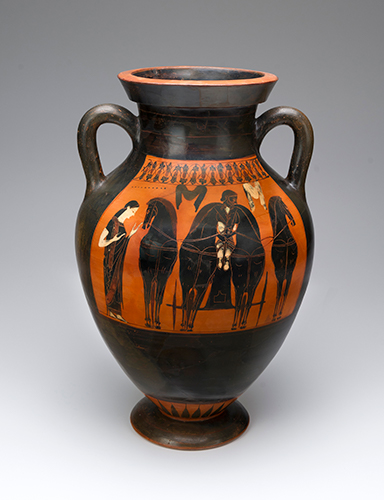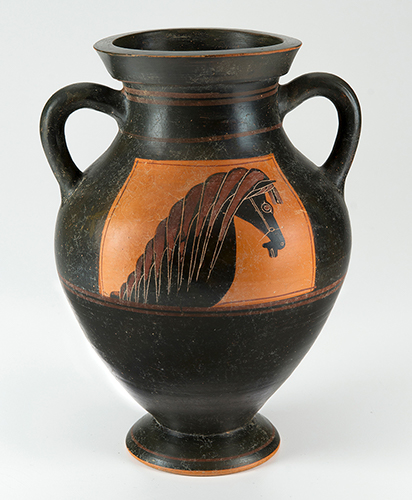Exhibitions
The Horse in Ancient Greek Art
Sep 9, 2017 - Jan 14, 2018
The Horse in Ancient Greek Art from NSLM on Vimeo.
Organized by the National Sporting Library & Museum and the Virginia Museum of Fine Arts
From myth and legend, to warfare and transportation, to leisure, sport, and Olympic competition, the horse played an integral role in ancient Greek culture. As symbols of wealth, power, and status, horses appear on the finest examples of ancient art and pottery. Imagery of both mythical and real horses fill Greek mythology, legend, and history and appear throughout ancient art. Vase-paintings depicting chariot horses being harnessed, jockeys riding, and grooms tending to well-bred steeds celebrate ancient sport and competition. Scenes of the care, training, and competition of the ancient sport horse and ancient texts on the Greek art of horsemanship bear striking resemblances to the horsemanship of today.
The Horse in Ancient Greek Art features Greek vases, sculpture, and coins from the 8th through the 4th centuries BCE drawn from private collections, the Virginia Museum of Fine Arts, the Tampa Museum of Art, and other museum collections. The exhibition and accompanying publication explore the significance of the horse in ancient Greek culture, and imagery of the horse in ancient myth, war, sport, and competition. From some of the earliest examples of the horse in Greek art, to stunning examples of black and red-figure vases, the objects on view illustrate ancient equestrian life.
The exhibition begins with early images of horses on objects from the Geometric Period (c. 900–700 BCE), named for the geometric patterns and intricate designs found on artwork from the era. From there, objects from the Archaic through the Classical Period (which ended in 323 BCE) are organized by key subjects. Myth and legend are illustrated with mythological horses and horse-hybrids, such as the famous winged-horse, Pegasos, and centaurs. The horse in war is depicted with scenes of ancient cavalry and chariots, followed by hunting, which was considered good training for both war and for competitive events. Horsemanship is explored with images of grooms tending their charges and examples of ancient tack. Finally, vases and coins showing equestrian sport reveal the significance of competition in the ancient Greek world and highlight the skills and accomplishments of ancient equestrians.
The Horse in Ancient Greek Art is made possible in part by support from
Frances Massey Dulaney
and
other private donors
Exhibition Catalog

Published by the National Sporting Library & Museum in partnership with the Virginia Museum of Fine Arts/Distributed by Yale University Press (September 2017).
Edited by co-curators Nicole Stribling, the Curator of Permanent Collections at the National Sporting Library & Museum and Peter Schertz, the Jack and Mary Ann Frable Curator of Ancient Art at the Virginia Museum of Fine Arts.
The fully illustrated publication features essays by notable scholars of ancient Greek art and archaeology: Seán Hemingway, Curator, Greek and Roman Art, The Metropolitan Museum of Art; Carol Mattusch, Mathy Professor Emerita of Art History, George Mason University; John Oakley, Chancellor Professor and Forrest D. Murden Jr. Professor of Classical Studies, The College of William and Mary in Virginia; Seth D. Pevnick, Chief Curator and Richard E. Perry Curator of Greek and Roman Art, Tampa Museum of Art; and exhibition co-curator, Peter Schertz; with an introduction by co-curator Nicole Stribling.
Venues:
National Sporting Library & Museum, Middleburg, Virginia, September 9, 2017 – January 14, 2018
Virginia Museum of Fine Arts, Richmond, February 17 – July 8, 2018

Attributed to the Swing Painter (Greek, Attic)
Black-figured Amphora, c. 540-535 BCE
terracotta
19 3/8 inches high
Private Collection
Photo: Claudia Pfeiffer
Attributed to the Swing Painter (Greek, Attic)
Black-figured Amphora, c. 540-535 BCE
terracotta
19 3/8 inches high
Private Collection
Photo: Claudia Pfeiffer

Attributed to the Workshop of Gorgon Painter (Greek, Attic)
Horse-head Amphora, ca. 580-570 BCE
terracotta
10 3/8 inches high, 7 1/4 inches wide
Private Collection
Photo: Claudia Pfeiffer
Attributed to the Workshop of Gorgon Painter (Greek, Attic)
Horse-head Amphora, ca. 580-570 BCE
terracotta
10 3/8 inches high, 7 1/4 inches wide
Private Collection
Photo: Claudia Pfeiffer

Greek
Statuette of a Horse, ca. 750-600 BCE
bronze
3 9/16 inches high, 7/8 inches wide, 3 1/4 inches long
Sidney and Lois Eskenazi Museum of Art, Indiana University
Photo: Kevin Montague
Greek
Statuette of a Horse, ca. 750-600 BCE
bronze
3 9/16 inches high, 7/8 inches wide, 3 1/4 inches long
Sidney and Lois Eskenazi Museum of Art, Indiana University
Photo: Kevin Montague

Etruscan
Horse bit, ca. 800-700 BCE
bronze
3 3/4 inches high, 6 inches wide, 5 inches long
Sidney and Lois Eskenazi Museum of Art, Indiana University
Photo: Kevin Montague
Etruscan
Horse bit, ca. 800-700 BCE
bronze
3 3/4 inches high, 6 inches wide, 5 inches long
Sidney and Lois Eskenazi Museum of Art, Indiana University
Photo: Kevin Montague

Attributed to the Underworld Painter
Greek (South Italian, Apulia)
(detail) Red-figure Lekythos, 350-340 BCE
A: Goddess abucting youth in chariot; B: Head of Medusa
terracotta
37 1/4inches high, 13 1/2 inches diameter
Virginia Museum of Fine Arts, Richmond. Adolph D. and Wilkins C. Williams Fund
Photo: Travis Fullerton © Virginia Museum of Fine Arts
Attributed to the Underworld Painter
Greek (South Italian, Apulia)
(detail) Red-figure Lekythos, 350-340 BCE
A: Goddess abucting youth in chariot; B: Head of Medusa
terracotta
37 1/4inches high, 13 1/2 inches diameter
Virginia Museum of Fine Arts, Richmond. Adolph D. and Wilkins C. Williams Fund
Photo: Travis Fullerton © Virginia Museum of Fine Arts

Attributed to the White Saccos-Chariot Group Painter
Greek (South Italian, Apulia)
Knob-handled Patera, ca. 320 BCE
Interior: Pegasos
terracotta
5 inches high, 15 inches wide, 14 inches diameter
Virginia Museum of Fine Arts, Richmond. Adolph D. and Wilkins C. Williams Fund
Photo: Travis Fullerton © Virginia Museum of Fine Arts
Attributed to the White Saccos-Chariot Group Painter
Greek (South Italian, Apulia)
Knob-handled Patera, ca. 320 BCE
Interior: Pegasos
terracotta
5 inches high, 15 inches wide, 14 inches diameter
Virginia Museum of Fine Arts, Richmond. Adolph D. and Wilkins C. Williams Fund
Photo: Travis Fullerton © Virginia Museum of Fine Arts

Attributed to the Orestes Painter
Greek (Attic)
Red-figure Column Krater, ca. 440 BCE
A: Jockeys racing around column; B: Three youths in conversation
terracotta
16 1/4 inches high, 14 3/8 inches wide, 12 1/8 diameter
Private Collection
Photo: Claudia Pfeiffer
Attributed to the Orestes Painter
Greek (Attic)
Red-figure Column Krater, ca. 440 BCE
A: Jockeys racing around column; B: Three youths in conversation
terracotta
16 1/4 inches high, 14 3/8 inches wide, 12 1/8 diameter
Private Collection
Photo: Claudia Pfeiffer

Euainetos of Syracuse, Sicily
Dekadrachum, ca. 405-400 BCE
silver
1 3/8 inches diameter
Private Collection, Washington, DC
Photo: Claudia Pfeiffer
Euainetos of Syracuse, Sicily
Dekadrachum, ca. 405-400 BCE
silver
1 3/8 inches diameter
Private Collection, Washington, DC
Photo: Claudia Pfeiffer

Attributed to the Virginia Painter
Greek (Attic)
Black-figure Cup, ca. 510 BCE
Interior: Traveler on horseback with dog
terracotta
4 7/8 inches high, w: 15 1/4 inches wide, 12 1/4 inches diameter
Virginia Museum of Fine Arts, Richmond. Adolph D. and Wilkins C. Williams Fund
Photo: Travis Fullerton © Virginia Museum of Fine Arts
Attributed to the Virginia Painter
Greek (Attic)
Black-figure Cup, ca. 510 BCE
Interior: Traveler on horseback with dog
terracotta
4 7/8 inches high, w: 15 1/4 inches wide, 12 1/4 inches diameter
Virginia Museum of Fine Arts, Richmond. Adolph D. and Wilkins C. Williams Fund
Photo: Travis Fullerton © Virginia Museum of Fine Arts
Exhibit Details
Open Sep 9, 2017 - Jan 14, 2018
Location: Museum
Newsletters
Publications
 The Horse in Ancient Greek Art catalog
The Horse in Ancient Greek Art catalog









